Plan to leave work early and drive up to Raetihi. Get held up at work with people coming in from 4 til just after 5. I hate that.
Drive to Wanganui, buy Chinese takeaways for tea and eat under Dublin street bridge. It was raining and there weren't any other places to park out of the rain. Go on to Raetihi, arriving at 9pm. Locate the motor camp and ask for a cabin. They're nearly full, but there is a portacom (A portacom is a portable shed, made of a aluminium/polystyrene sandwich. Often used on construction sites) empty. We spend the night in an old Hawkins construction portacom. There is a kitchen sink, but no running water. The cooking facility is a LPG bottle on the floor and a two ring cooker on the table. Lucky we just want to sleep.
Pack up and drive to the Raetihi-Ohura road. Drive for about an hour to the start of the track. Unload the bikes from the car, pack up our gear and start riding.
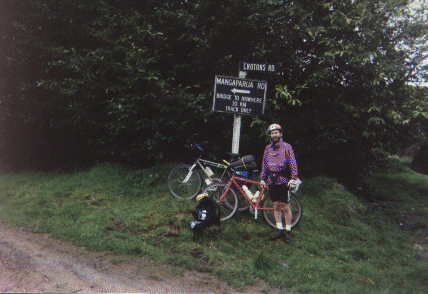
The track is a good farm track with a few obstacles where watercourses have carved up the surface. It is very wet and the surface is often clay. Sometimes the clay gives good traction, sometimes it doesn't. We go uphill for over an hour, then along the tops to the Mangaparua trig.
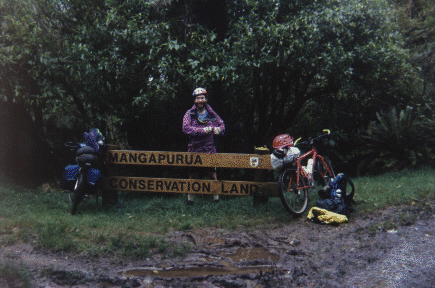
It's all easy going so far, the grade is not to steep and we have only dismounted at a few obstacles. We come to a sign telling us we are now in the Whanganui National Park.
Now we go downhill and the track is rougher. Perhaps another hour and we come to the first sign of the work that has been done to improve access. There is a walking bridge across a stream. The stream is in the bottom of a gully, with steep clay sides. It would have been a major job to cross without the bridge. From here on the track is a walking track. There a many rideable sections interrupted by bridges and obstacles that require dismounting for.
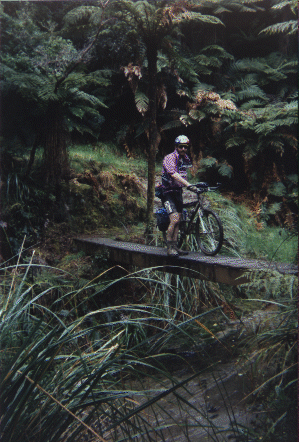
The track follows the old road, so it is an easy grade but the country we are going through is very steep. We are often going along the side of steep hills and bluffs. Phil E. takes a dive off a bridge once, but luckily the chute it was over was full of foliage and trees. He grabbed some weeds as he went over and only fell a few metres. His bike caught on some branches below him and was undamaged. It made a good photo. The chute went down a long way, at least 50 feet, maybe 100 or more. We were more careful on the bridges after that.
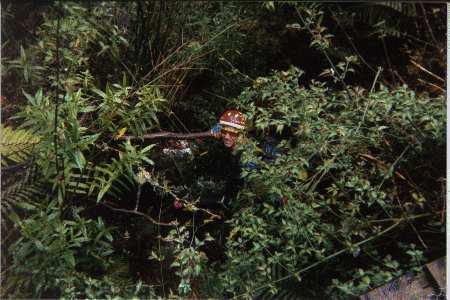
Many bridges were bare planks on top and very slippery. The Department Of Conservation (DOC) track maintenance workers were putting wire mesh over the top of the planks to make the bridges safer. Some bridges had handrails! There were three swing bridges. Swing bridges are too narrow for the handlebars of the bikes, so we stand the bikes up on the back wheel and push the over while holding them vertical. The handlebars just clear the sides of the bridge when we did this.
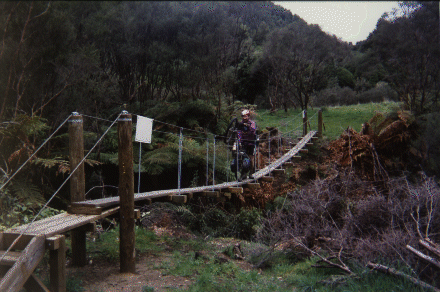
We met some DOC workers about 5 hours into the trip, they were doing a great job clearing the bush from the track, putting in bridges, cutting steps, and cutting the track back into the sides of the hills. The improvement was noticeable when we came near where they were working. They were surprised at how far we had come, and said it was about two hours walk to the derelict hut near the bridge. It actually takes us about 4 hours. They must be fast walkers! The track is very rough in that area, although it is very noticeable where the workers have improved the track.
After about 7 hours, my knees started giving me trouble, probably as a result of my introduction to snowboarding the weekend before, combined with the increasingly difficult terrain. This slowed me down a bit, particularly getting on and off the bike at obstacles.
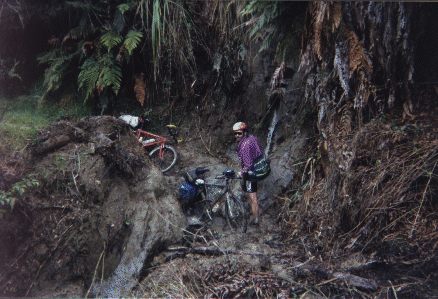
After just over 9 hours we got to the bridge! It just appeared as we rounded a turn in the track. There was no sign of the road that had led to and from the bridge, just a small clearing at each end that would have been a tight fit to pitch our tents. The bridge is in good condition and looks really strange in the middle of the bush. A welcome sight after a hard ride.
The text of a sign by the Bridge To Nowhere:
Started in January 1935 and completed in June 1936, this bridge was built by the Raetihi firm of Sandford and Brown, for the Public Works Department. It is 130 feet long, and 125 feet above the stream. The cost of labour was 598 pounds 11 shillings 7 pence, and cartage of all materials (via the Mangapurua Valley road) cost 419 pounds 14 shillings. Unfortunately the cost of materials was not recorded. Aggregate for the concrete is said to have been transported from the Rangitikei River. The completion of the bridge was delayed considerably due to floods, slips, and the consequent delay in the supply of materials.
The bridge was built to facilitate vehicular access to the Wanganui River, to link the settlers of the valley with the riverboat service.
In 1917 the Government opened up the valley for settlement by soldiers returning from the Great War. Virgin forest was cleared, and a total of 35 holdings developed. A school was opened, and for some years the valley prospered. However economic hardship, and problems associated with the remoteness and difficulty of access, resulted in many families abandoning their farms. By 1942 there were only 3 families left. After a major flood in January 1942 the Government declined to make further funds available for road maintenance, and it officially closed the valley in May 1942.
The disappearing roadline, old fencelines, stands of exotic trees, occasional brick chimneys, and this bridge serve as reminders of the ill fated settlement of the Mangapurua valley.
We then carried on the the landing by the Wanganui River to camp for the night. I was surprised to find the landing was just a track down to the river, and the only area large enough to pitch the tents was by a sign in the bush above the landing. DOC had kindly put a toilet by the landing, one of their flash new long-drops that was very clean and didn't smell. An unexpected bonus in such a remote spot. I guess they cater to the tourists who come up the river in jet boats to see the bridge.
We were taking the precaution of boiling all our water because it's not really a good idea to drink from the river. Boiling such a large quantity of water used up nearly all the gas for the cooker. In the evening an opossum (possum) visited to check our billy and waterbottles in case there was some food left. Phil E. went out to do battle and scared it off for a few minutes, until he was comfortably in bed again. This time he left the possum to it.
On the way in we had noticed quite a bit of possum damage in the bush. One tree was completely stripped of all foliage and the ground around it was covered in possum droppings. They are destructive little pests.
There are also goats in the area. Goat cullers are employed to try and reduce the population, and there was plenty of evidence of their work. Dead goats were a common sight (and smell) just off the track. Plenty of live ones too. Also plenty of evidence of the few wild cattle still in the area. They make a mess of the track, make it impossible to ride in some places and even hard to walk. The DOC workers said there were only 4 or 5 cattle left in the area after a recent cull.
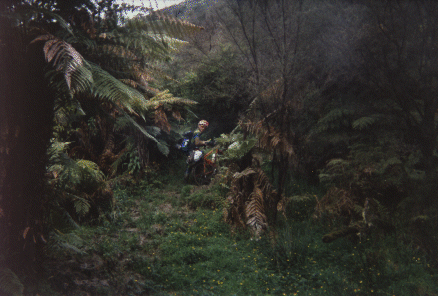
We packed up and moved out early. My knees were still giving trouble but were OK for riding. At the Bridge we stopped and took a few photos. When we hit the tough going I had a lot of trouble getting on and off the bike, so we were slowed down a lot. The hardest part of the track was covered in the morning, but when we got to the parts that we had charged down the day before I was unable to ride up the slope due to the knee problems and the minor but frequent obstacles. This slowed progress even more.
I had panniers on my bike, while Phil E. carried everything except his sleeping bag in his pack. By the afternoon Phil E. was pushing my bike through the hard stuff and I was pushing his. The extra weight on my bike was very noticeable when pushing and carrying.
We wanted to get out that day, but as the day dragged on we decided to stop at the next good campsite unless we came to the formed road before dark. Luckily we found a campsite just on dusk, around 7.30. The last area we had passed that was flat and large enough to camp on was about 2 hours back.
There was no water at the campsite, and as we had no spare we were not in a good position. Phil E. had filled a water bottle from the water running across the track an hour earlier, so we set up our tents and started to boil the water. The cooker ran out of gas before the water was hot. It was dark at this stage, so we crawled into our sleeping bags and went to sleep.
We rolled out of our tents early, had a breakfast of muesli, drank the last mouthful of water from one of our bottles and got ready to move. We were on the formed road now, and only had a half hour or so of uphill. At the top of a saddle we finished off the other water bottle, one sip each, and attacked the downhill. There were still a few obstacles to negotiate, but by 10 we were at the car. It felt good.
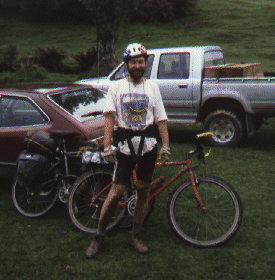
Time to clean up. I had some scratches on my shins that I knew were there, but Phil E. seemed surprised when he found blood under the mud on his legs. He had worn lycra tights the first day, mainly to keep his legs clean, and hadn't noticed when he'd scratched himself the next day. Rubbing damp mud off your legs with a towel really lets you know were all those scratches are.
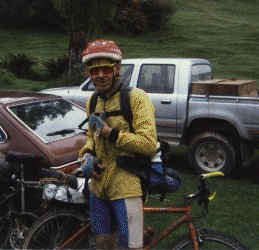
We looked for access to the stream to wash ourselves and our bikes, but the stream was in the bottom of a deep gully that we would not have been able to climb out of easily, so we didn't bother. After knocking the worst of the mud off we packed up the car and headed towards the delights of Raetihi. It was about an hours drive. We were looking forward to a feed and a drink. Remember, we hadn't had a decent drink since the day before and were feeling a bit dry.
At around 11 we hit town and found a coffee shop / restaurant that was open. A suitably large feed was ordered, and you can bet it was appreciated. Best meal I'd tasted in a while. After that feed we waddled out to the car making satisfied noises and headed home.
